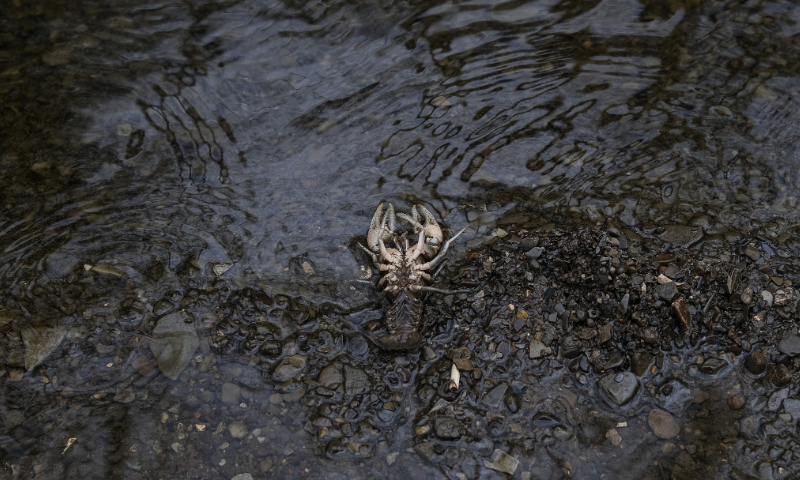
A dead crustacean is seen in Leslie Run creek in East Palestine, Ohio, US, on February 20, 2023. Photo: VCG
Three weeks after the "toxic train" incident in Ohio, US, the local department of natural resources has increased its estimate of the number of animals killed by the hazardous chemicals to nearly 44,000. This has raised concerns among agricultural experts and Chinese consumers regarding food security issues.
The original estimate was about 3,500 dead aquatic animals shortly after the train derailment, The Hill reported on Friday.
When detecting agricultural pollution, an important metric in the industry is not to look at mammals, but aquatic animals, because they are more sensitive to environmental changes, experts said.
"Just by looking at the fish in the nearby water, you can tell the severity and impact of the pollution," Wang Gangyi, a professor at Northeast Agricultural University, told the Global Times on Friday, regarding the large number of aquatic animals found dead in the surrounding river and lake.
The aftermath of the Ohio train derailment on February 3, which resulted in toxic chemicals being released into the environment, has left the local community reeling.
As chemicals fill the air and seep into the ground, food producers and consumers are asking questions about the impact of the release of these chemicals on food safety and on crops and livestock, Food Safety News reported.
A local farmer, Pam Mibuck, said her white turkeys have been put on antibiotics due to respiratory problems, and her chickens have laid eggs with an unsettling purple hue, the New York Times reported.
While Mibuck did not feel like moving from her hometown, she conceded that she does not feel safe living there anymore, as she is concerned about eating the fruit from her trees and letting her horses drink from the nearby creek.
Ohio has about 75,000 farms, and ranks first in the country in the production of Swiss cheese, second in egg production, and third in tomatoes and pumpkins, according to media reports.
Contaminated water is another major concern for food safety, as trace amounts of chemicals spilled from the train derailment have been found in the Ohio River. Its basin runs into the Mississippi River, the second-longest river and chief river of the second-largest drainage system in North America.
Although the local environmental protection agency reiterated that water in Ohio is safe, residents say they have found dead fish near waterways in recent days.
Regions near the Ohio River are shutting down intakes as a "precautionary measure for the time being," local news reports said.
"The incident has caused great concern in China's domestic animal husbandry circles, especially when it come to the potential impact on animal feed, because the source of corn in our livestock and poultry feed is mainly from the US," Wang said.
However, the impact to the feed supply in China is controllable. "Given the fact that Ohio's corn accounts for a limited amount of corn production in the country, coupled with China's ability to detect harmful chemicals, we are not particularly worried that it will affect the domestic supply of agricultural products," the expert noted.
Moreover, China has diversified its sources of corn and soybean to include South American countries such as Argentina and Brazil in recent years.
Still, Wang was surprised at the way such dangerous chemicals are disposed of in the US.
Incineration is a very unprofessional way to deal with chemicals, since the incineration of vinyl chloride produces a large amount of dioxins, which will have a great impact on the surrounding environment, the expert said.
"The harm can reach 10-20 years. Such effects include its high carcinogenicity and it may cause fetal malformations," Wang said, adding that the excess proportion of new cancers may be difficult to measure in the short term.




